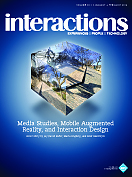Authors:
Jonathan Bean, Daniela Rosner
There are so many new words for what seems, on the face of it, to be a new phenomenon [1]. Images and widgets are sliding off the screen and ending up in what geographers call the cultural landscapeand what the rest of us call the real world. Facebook "Like" icons supplement graffiti. End tables are painted to resemble Nintendo controllers. T-shirts for sale at hip markets are plastered with Atari graphics. "The New Aesthetic" "Tangiblasts" "Boomeranged metaphors" "Eversion" "Flip flop" "Meatspacing" But is "meatspacing" really new? People have long shown a talent for decoding, manipulating, and reappropriating symbols. In…
You must be a member of SIGCHI, a subscriber to ACM's Digital Library, or an interactions subscriber to read the full text of this article.
GET ACCESS
Join ACM SIGCHIIn addition to all of the professional benefits of being a SIGCHI member, members get full access to interactions online content and receive the print version of the magazine bimonthly.
Subscribe to the ACM Digital Library
Get access to all interactions content online and the entire archive of ACM publications dating back to 1954. (Please check with your institution to see if it already has a subscription.)
Subscribe to interactions
Get full access to interactions online content and receive the print version of the magazine bimonthly.






